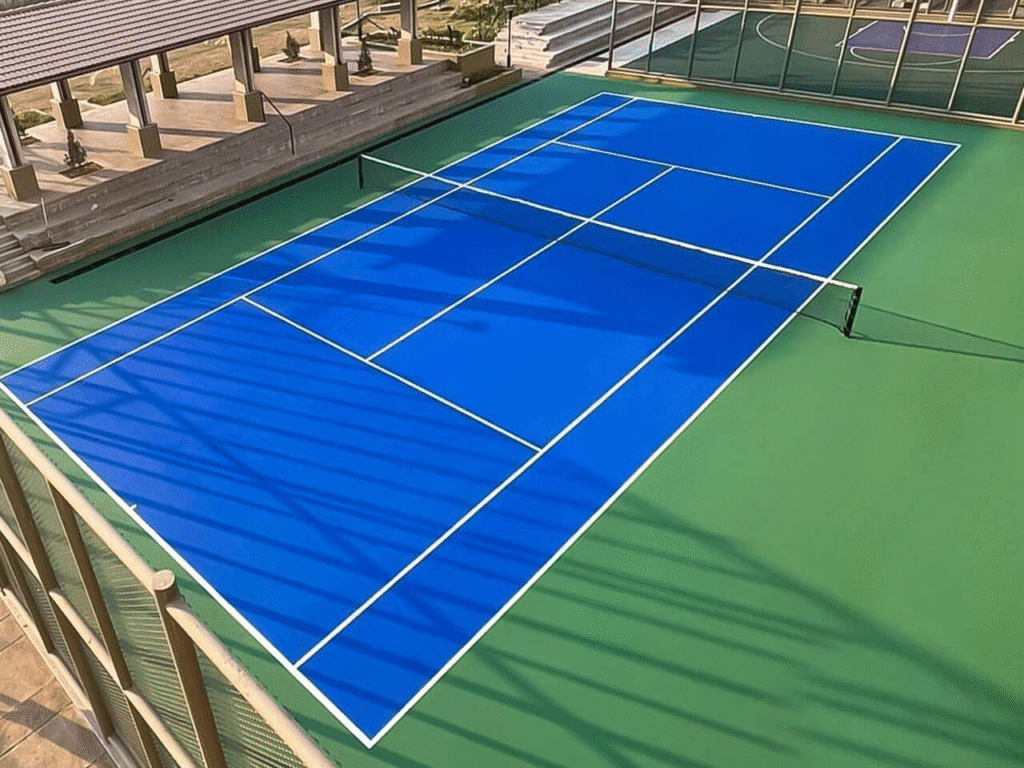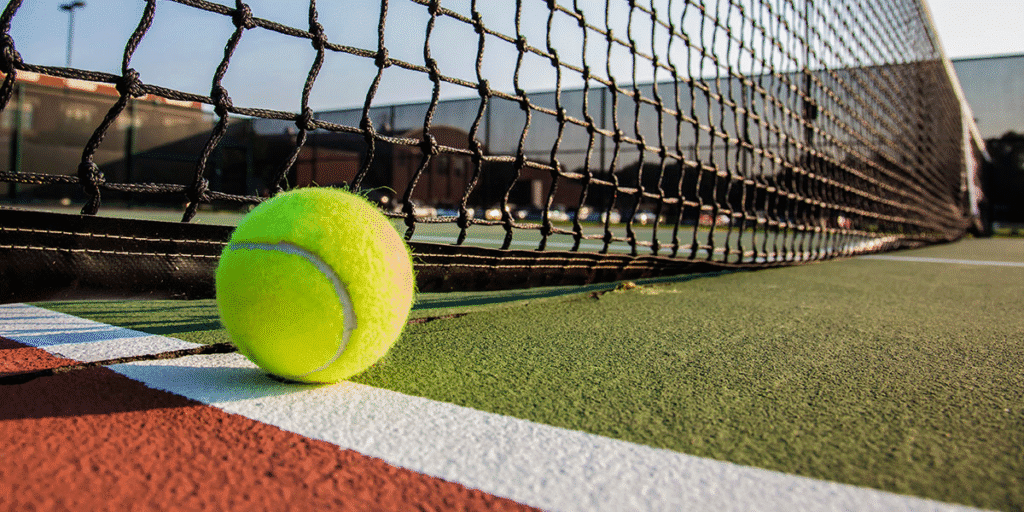Choosing the right manufacturer for a tennis court is a decision that influences everything from player safety to long-term maintenance costs. In India, a growing passion for tennis has spurred demand for high-quality courts across clubs, schools, and private residences. This has led to a competitive market filled with companies offering a wide range of surfaces. To help you find the Best Tennis Court Flooring Manufacturer in India, this guide will navigate the industry, spotlighting the top manufacturers, and providing the insights needed to select the perfect partner for your project. We will explore the factors that set leading manufacturers apart, detail their specializations, and offer practical advice for making your selection.
Table of Contents
The Indian Tennis Court Flooring Market

The sports infrastructure landscape in India is expanding rapidly. Government initiatives like Khelo India, coupled with rising disposable incomes and a greater focus on health and wellness, have fueled the construction of new sports facilities. Tennis, with its growing viewership and roster of international stars, is a key part of this boom.
This has created significant demand for durable, high-performance tennis court surfaces. Consequently, the market now supports a mix of domestic manufacturers and Indian partners of international brands. The trend is shifting from basic concrete courts to professionally installed, layered systems like acrylic hard courts and artificial turf, which offer better performance and player comfort.
Why Tennis Court Flooring Matters
The surface under a player’s feet is one of the most fundamental elements of tennis. While rackets and player skill often get the spotlight, the court surface itself quietly dictates the nature of the game. It is a critical factor that influences everything from the speed of a rally to player safety and a facility’s long-term budget. For facility managers, contractors, and players, understanding the significance of tennis court flooring is essential for making smart investments and maximizing performance.
This article will explore why tennis court flooring is so much more than just a playing area. We will examine its direct impact on player performance, injury prevention, maintenance demands, and the overall experience for everyone involved in the sport.
The Impact on Player Performance and Game Style
The type of court surface directly shapes the style of play. It governs how the ball behaves and how players move, creating distinct challenges and advantages. The three key performance elements affected are ball bounce, speed, and player movement.
Ball Bounce and Speed
Each surface interacts with the tennis ball differently, affecting both the height of its bounce and its pace after hitting the ground.
- Hard Courts: Made of acrylic layers over asphalt or concrete, hard courts offer a true, predictable, and high bounce. The speed of the game can be customized by adjusting the amount of sand in the topcoat. This consistency makes it a great surface for all-around players and is the most common surface on the professional tour.
- Clay Courts: Composed of crushed brick or shale, clay slows the ball down significantly and produces a very high bounce. This leads to longer, more grueling rallies that favor strategic, defensive players with exceptional stamina.
- Grass Courts: Natural grass is the fastest surface in tennis. The slick blades cause the ball to stay low and skid, rewarding players with powerful serves and a strong net game. Bounces can be unpredictable, demanding quick reflexes.
Player Movement and Footing
The surface also dictates how players can move and position themselves. On a hard court, players rely on precise footwork with a stop-and-start motion. The surface offers good grip but provides little give.
In contrast, clay courts allow players to slide into their shots. This sliding technique helps players conserve energy, change direction quickly, and recover for the next shot more efficiently. Grass courts, being softer and sometimes slippery, require players to use smaller, more careful steps to maintain balance.
Enhancing Player Safety and Preventing Injuries

A tennis match is a high-impact athletic event involving sprinting, jumping, and sudden changes of direction. The right flooring plays a crucial role in mitigating the physical toll this takes on a player’s body.
An overly hard or unforgiving surface can lead to significant stress on the joints, particularly the ankles, knees, and lower back. This can result in both acute injuries and chronic conditions over time. Modern hard courts increasingly incorporate cushioning layers made from rubber or other shock-absorbing materials to reduce this impact. These systems provide a balance between performance and player comfort.
Softer surfaces like clay and artificial turf are naturally more forgiving. The give in a clay court and the cushioning of a turf system help absorb shock, reducing the cumulative strain on a player’s body. This makes them an excellent choice for recreational clubs, senior players, or training facilities where player longevity is a priority.
Adapting to Climate and Usage Scenarios
There is no one-size-fits-all solution for tennis court flooring. The ideal choice depends heavily on the local climate and how the court will be used.
In regions with extreme heat, hard courts can absorb and radiate high temperatures, making play uncomfortable. Lighter color choices can help mitigate this. For areas with heavy rainfall, clay courts can become unplayable for extended periods unless they are properly covered or have excellent drainage systems. Natural grass thrives only in temperate climates and cannot withstand constant, heavy use.
The usage level is another critical factor. A private court at a residence will experience far less wear than the courts at a busy public park or tennis academy. A highly durable and low-maintenance surface like a hard court or artificial turf is often the best choice for high-traffic facilities.
The Overall Experience for Players and Spectators
Finally, the court surface contributes to the overall aesthetic and atmosphere of a tennis facility. The iconic red of a clay court, the pristine green of a grass court, or the vibrant blue and green of a modern hard court all create a distinct visual appeal.
For players, a well-maintained, high-quality surface inspires confidence and allows them to play their best tennis. A court with cracks, uneven bounces, or poor footing is not only unsafe but also frustrating. For spectators, the speed and style of play dictated by the surface can make for a more exciting viewing experience, whether it’s the fast-paced action on grass or the epic rallies on clay.
In conclusion, the choice of tennis court flooring is a foundational decision that shapes every aspect of the game. By carefully considering the impacts on performance, safety, maintenance, and overall experience, facility managers and players can ensure they select a surface that provides value, safety, and enjoyment for years to come.
What Defines a Top Manufacturer?

With numerous options available, it can be challenging to distinguish a truly exceptional manufacturer from the rest. The best companies stand out through a combination of tangible quality and excellent service.
- Product Quality and Certifications: Leading manufacturers use premium-grade raw materials to ensure their surfaces are durable, weather-resistant, and provide consistent play. Look for certifications from bodies like the International Tennis Federation (ITF), which classifies court pace and guarantees adherence to global standards.
- Innovation and Technology: The industry is constantly evolving. Top manufacturers invest in research and development to offer advanced cushioning systems, eco-friendly materials, and surfaces that reduce player fatigue and risk of injury.
- Turnkey Solutions: The best partners do more than just supply materials. They offer end-to-end services, including site assessment, base construction, surface installation, line marking, and fencing. This holistic approach ensures quality control at every stage.
- Customer Service and Portfolio: A strong reputation is built on successful projects and satisfied clients. Look for manufacturers with an extensive portfolio of completed courts, positive testimonials, and responsive post-installation support.
Tips for Choosing the Right Manufacturer
Selecting a manufacturer is a significant investment. Use these tips to guide your decision-making process.
- Define Your Project Needs: First, determine the primary use of the court. Will it be for professional training, recreational club play, or a private residence? This will help you decide on the best surface type—whether it’s a versatile hard court, a joint-friendly cushioned surface, or a premium artificial turf.
- Verify Quality and Certifications: Always ask for technical data sheets, product specifications, and proof of certifications like ITF classification. This ensures the product you are buying meets recognized performance and quality standards.
- Request a Portfolio and References: Ask the manufacturer for a list of recent projects similar to yours. If possible, visit a nearby installation to see the surface quality firsthand and speak with the facility manager about their experience.
- Evaluate Installation Expertise: The best materials can fail if installed incorrectly. Ensure the manufacturer or their approved installer has a proven track record. Inquire about their process for base preparation, as this is the foundation for a long-lasting court.
- Consider Long-Term Maintenance and Budget: Discuss the total cost of ownership, not just the initial installation price. A cheaper upfront cost might lead to higher maintenance expenses later. Ask about warranty, after-sales support, and the expected lifespan of the surface.
By conducting thorough research and prioritizing quality, you can partner with a manufacturer who will deliver a world-class tennis court that serves players and meets your facility’s goals for years to come.
FAQ’s
Who is the Best Tennis Court Flooring Manufacturer in India?
The best tennis court flooring manufacturer in India is one that offers high-quality surfaces, advanced technology, certified materials, and excellent after-sales support. Brands like Pacecourt, Tennisflooring, and other reputed manufacturers are known for delivering durable and professional-grade tennis courts.
What is the cost of tennis court flooring in India?
The cost of tennis court flooring in India varies between ₹250–₹800 per sq. ft., depending on the type of surface (acrylic, synthetic, clay, or grass), installation requirements, and customization.
Which type of tennis court flooring is best for Indian weather?
For India’s diverse climate, acrylic and synthetic tennis court flooring are the most popular choices because they are durable, weather-resistant, and low-maintenance compared to natural grass or clay courts.
How long does tennis court flooring last in India?
With proper maintenance, a well-installed tennis court floor can last 8–15 years, depending on the material and usage frequency. Regular resurfacing extends its lifespan.
Can tennis court flooring be customized in India?
Yes, most manufacturers offer customized court flooring in terms of cushioning, surface texture, and color to meet international standards or personal preferences.
